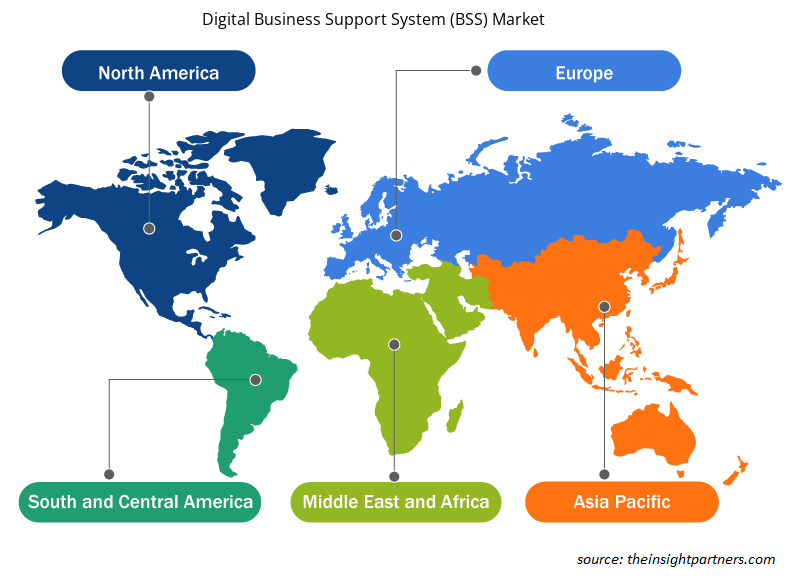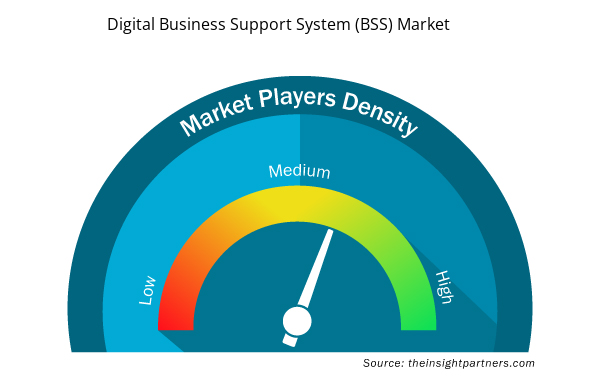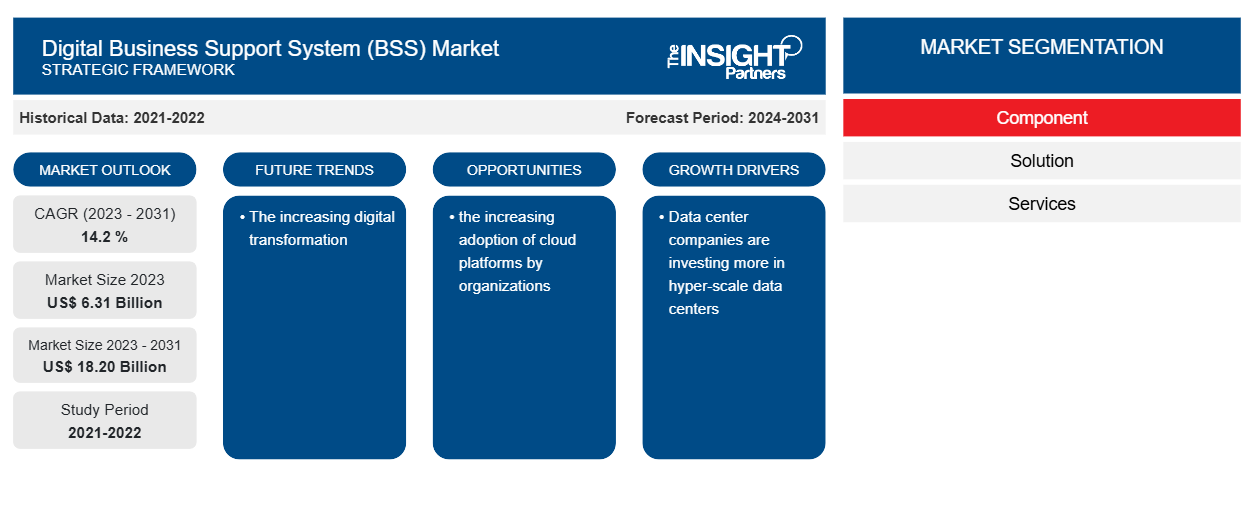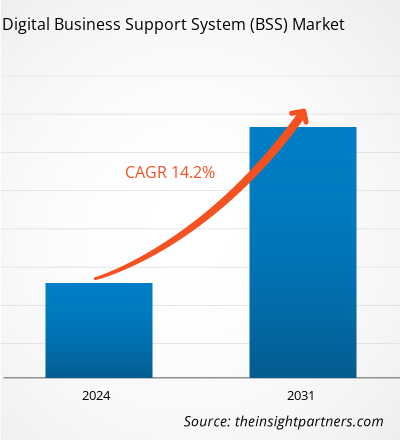من المتوقع أن يصل حجم سوق نظام دعم الأعمال الرقمية ( BSS ) إلى 18.20 مليار دولار أمريكي بحلول عام 2031 من 6.31 مليار دولار أمريكي في عام 2023. ومن المتوقع أن يسجل السوق معدل نمو سنوي مركب بنسبة 14.2٪ في الفترة 2023-2031.المن المرجح أن يظل التحول الرقمي المتزايد أحد الاتجاهات الرئيسية في سوق نظام دعم الأعمال الرقمية ( BSS ).
تحليل سوق نظام دعم الأعمال الرقمية ( BSS )
يشهد سوق أنظمة دعم الأعمال الرقمية نموًا سريعًا بسبب عدد من العوامل، بما في ذلك التبني المتزايد لحلول BSS المصممة خصيصًا والنماذج التجارية الجديدة، وارتفاع تكاليف التشغيل المخفضة، وزيادة المعاملات عبر الإنترنت، واستخدام أجهزة محمولة متعددة، والافتراض المتزايد لحلول BSS المستندة إلى السحابة ، واتجاه التحول الرقمي المتزايد في صناعة الاتصالات، والتبني المتزايد لأنظمة دعم الأعمال الرقمية من الشركات المصنعة من أجل إضافة قيمة إلى الأعمال من خلال تعظيم العائد على الاستثمار وتوفير خدمة عملاء فائقة، وخفض التكاليف، وتسريع الوقت اللازم لتسويق المنتجات والخدمات الجديدة.
نظرة عامة على سوق نظام دعم الأعمال الرقمية ( BSS )
نظام دعم الأعمال الرقمي هو نوع من المنصات أو الحلول التي توفر للشركات التجارية مزايا تشغيلية ومراقبة. إن تلقي الطلبات والاستفسارات المتعلقة بالدفع وإدارة دخل العميل كلها جزء من نظام دعم الأعمال. بالإضافة إلى تقديم العديد من أدوات إدارة العمليات الإضافية، يمنح النظام الشركات رؤى تسويقية وعملياتية للشركة، مما يمكّنها من اتخاذ قرارات مستنيرة بشأن إطلاق المنتجات ونفقات التسويق .
قم بتخصيص هذا التقرير ليناسب متطلباتك
ستحصل على تخصيص لأي تقرير - مجانًا - بما في ذلك أجزاء من هذا التقرير، أو تحليل على مستوى الدولة، وحزمة بيانات Excel، بالإضافة إلى الاستفادة من العروض والخصومات الرائعة للشركات الناشئة والجامعات
- احصل على أهم اتجاهات السوق الرئيسية لهذا التقرير.ستتضمن هذه العينة المجانية تحليلاً للبيانات، بدءًا من اتجاهات السوق وحتى التقديرات والتوقعات.
محركات وفرص سوق نظام دعم الأعمال الرقمية ( BSS )
تستثمر شركات مراكز البيانات المزيد في مراكز البيانات الضخمة.
وقد قامت العديد من شركات مراكز البيانات باستثمارات كبيرة في مراكز البيانات الضخمة، والتي من المتوقع أن تسفر عن آفاق توسع مربحة. وكشفت شركة Equinix عن نيتها بناء حوالي 32 مركز بيانات ضخم في عدد قليل من الأسواق الأوروبية المهمة العام الماضي. وباستثمار أكثر من 6.9 مليار دولار أمريكي وسعة إجمالية تزيد عن 600 ميغاواط، تأمل الشركة في تحسين مكانتها في سوق مراكز البيانات الضخمة سريعة التطور. ومن المتوقع أن يرتفع الطلب على سوق الحوسبة عالية الأداء في المنطقة نتيجة لهذا التوسع في مراكز البيانات في المنطقة.
الاعتماد المتزايد على منصات الحوسبة السحابية من قبل المؤسسات
من المتوقع أن يؤدي التبني المتزايد للمنصات السحابية من قبل المؤسسات، وخاصة في الدول الناشئة، إلى دفع نمو سوق نظام دعم الأعمال الرقمية في منطقة آسيا والمحيط الهادئ. على سبيل المثال، من المتوقع أن يتضاعف اعتماد أحمال العمل السحابية الهجينة في الهند من 13% إلى 43%، وفقًا لمؤشر Nutanix Cloud Index. تركز الشركة بشكل أكبر على توسيع الأعمال وتطوير المنتجات الجديدة نتيجة للاستخدام المتزايد للتقنيات الرقمية لإشراك المستهلك. وبالتالي، من المتوقع أن تقدم الحاجة المتزايدة إلى دقة البيانات وإدارة البيانات فرصًا جديدة للاعبين في سوق نظام دعم الأعمال الرقمية ( BSS ) خلال فترة التنبؤ.
تقرير تحليل تجزئة سوق نظام دعم الأعمال الرقمية ( BSS )
إن القطاعات الرئيسية التي ساهمت في اشتقاق تحليل سوق نظام دعم الأعمال الرقمية ( BSS ) هي المكونات.
- استنادًا إلى المكون، يتم تقسيم سوق نظام دعم الأعمال الرقمية ( BSS ) إلى حلول وخدمات. احتل قطاع الخدمات حصة سوقية أكبر في عام 2023.
تحليل حصة سوق نظام دعم الأعمال الرقمية ( BSS ) حسب المنطقة الجغرافية
ينقسم النطاق الجغرافي لتقرير سوق نظام دعم الأعمال الرقمية ( BSS ) بشكل أساسي إلى خمس مناطق: أمريكا الشمالية، ومنطقة آسيا والمحيط الهادئ، وأوروبا، والشرق الأوسط وأفريقيا، وأمريكا الجنوبية/أمريكا الجنوبية والوسطى. من حيث الإيرادات، استحوذت أمريكا الشمالية على أكبر حصة في سوق نظام دعم الأعمال الرقمية ( BSS ). وبالمقارنة مع المناطق الأخرى، تشهد أمريكا الشمالية نموًا أسرع في ثقافة الشركات الناشئة. وقد ساهم ظهور الشركات الصغيرة والمتوسطة الحجم والرقمنة المتنامية لصناعة الاتصالات في توسيع سوق نظام دعم الأعمال الرقمية ( BSS ) في أمريكا الشمالية. إن إمكانية الوصول المتزايدة إلى الحلول المستندة إلى السحابة هي عامل آخر يدفع المنطقة إلى تبني حلول نظام دعم الأعمال الرقمية (BSS) . وبالمقارنة مع الحلول التقليدية المحلية، تتمتع حلول نظام دعم الأعمال الرقمية (BSS) المستندة إلى السحابة بمجموعة متنوعة من الفوائد، مثل انخفاض التكاليف الأولية، وزيادة الأمان، وقابلية التوسع المرنة. ومن المرجح أن تساهم هذه العناصر في استمرار نمو أمريكا الشمالية في تبني حلول نظام دعم الأعمال الرقمية (BSS) في السنوات القادمة.
رؤى إقليمية حول سوق نظام دعم الأعمال الرقمية (BSS)
لقد قام المحللون في Insight Partners بشرح الاتجاهات والعوامل الإقليمية المؤثرة على سوق نظام دعم الأعمال الرقمية (BSS) طوال فترة التوقعات بشكل شامل. يناقش هذا القسم أيضًا قطاعات سوق نظام دعم الأعمال الرقمية (BSS) والجغرافيا في جميع أنحاء أمريكا الشمالية وأوروبا ومنطقة آسيا والمحيط الهادئ والشرق الأوسط وأفريقيا وأمريكا الجنوبية والوسطى.

- احصل على البيانات الإقليمية المحددة لسوق نظام دعم الأعمال الرقمية (BSS)
نطاق تقرير سوق نظام دعم الأعمال الرقمية (BSS)
| سمة التقرير | تفاصيل |
|---|---|
| حجم السوق في عام 2023 | 6.31 مليار دولار أمريكي |
| حجم السوق بحلول عام 2031 | 18.20 مليار دولار أمريكي |
| معدل النمو السنوي المركب العالمي (2023 - 2031) | 14.2% |
| البيانات التاريخية | 2021-2022 |
| فترة التنبؤ | 2024-2031 |
| القطاعات المغطاة | حسب المكون
|
| المناطق والدول المغطاة | أمريكا الشمالية
|
| قادة السوق وملفات تعريف الشركات الرئيسية |
|
كثافة اللاعبين في سوق نظام دعم الأعمال الرقمية (BSS): فهم تأثيره على ديناميكيات الأعمال
يشهد سوق نظام دعم الأعمال الرقمية (BSS) نموًا سريعًا، مدفوعًا بالطلب المتزايد من المستخدم النهائي بسبب عوامل مثل تفضيلات المستهلكين المتطورة والتقدم التكنولوجي والوعي الأكبر بفوائد المنتج. ومع ارتفاع الطلب، تعمل الشركات على توسيع عروضها والابتكار لتلبية احتياجات المستهلكين والاستفادة من الاتجاهات الناشئة، مما يؤدي إلى زيادة نمو السوق.
تشير كثافة اللاعبين في السوق إلى توزيع الشركات أو المؤسسات العاملة في سوق أو صناعة معينة. وهي تشير إلى عدد المنافسين (اللاعبين في السوق) الموجودين في مساحة سوق معينة نسبة إلى حجمها أو قيمتها السوقية الإجمالية.
الشركات الرئيسية العاملة في سوق نظام دعم الأعمال الرقمية (BSS) هي:
- شركة أمدوكس المحدودة
- شركة هواوي للتكنولوجيا المحدودة
- Telefonaktiebolaget LM إريكسون
- شركة نت كراكر للتكنولوجيا
- شركة سي إس جي سيستمز الدولية
- شركة أوبتيفا
إخلاء المسؤولية : الشركات المذكورة أعلاه ليست مرتبة بأي ترتيب معين.

- احصل على نظرة عامة على أهم اللاعبين الرئيسيين في سوق نظام دعم الأعمال الرقمية (BSS)
أخبار السوق والتطورات الأخيرة لنظام دعم الأعمال الرقمية (BSS)
يتم تقييم سوق نظام دعم الأعمال الرقمية (BSS) من خلال جمع البيانات النوعية والكمية بعد البحث الأولي والثانوي، والذي يتضمن منشورات الشركات المهمة وبيانات الجمعيات وقواعد البيانات. فيما يلي قائمة بالتطورات في سوق اضطرابات الكلام واللغة والاستراتيجيات:
- في يونيو 2023، وقعت شركة IBM وVista Equity Partners صفقة نهائية لشركة IBM للاستحواذ على شركة Apptio Inc. ستنمو قدرات أتمتة تكنولوجيا المعلومات الخاصة بشركة IBM بشكل أسرع نتيجة للاستحواذ على Apptio، مما يمنح المديرين التنفيذيين للشركة القدرة على تعظيم العائد على استثماراتهم في تكنولوجيا المعلومات.
(المصدر: IBM، بيان صحفي)
- في يوليو 2022، اشترت شركة إريكسون شركة فوناج، مما أدى إلى تقدم خطة الشركة لاستخدام مكانتها كشركة رائدة في مجال التكنولوجيا لتعزيز أعمال شبكات الهاتف المحمول والتغلغل في المؤسسات.
(المصدر: إريكسون، بيان صحفي)
تقرير سوق نظام دعم الأعمال الرقمية (BSS) والتغطية والنتائج المتوقعة
يوفر تقرير "حجم سوق نظام دعم الأعمال الرقمية (BSS) والتوقعات (2021-2031)" تحليلاً مفصلاً للسوق يغطي المجالات التالية:
- حجم السوق والتوقعات على المستويات العالمية والإقليمية والوطنية لجميع قطاعات السوق الرئيسية التي يغطيها النطاق
- ديناميكيات السوق مثل المحركات والقيود والفرص الرئيسية
- الاتجاهات المستقبلية الرئيسية
- تحليل مفصل لقوى PEST/Porter الخمس وSWOT
- تحليل السوق العالمي والإقليمي الذي يغطي اتجاهات السوق الرئيسية واللاعبين الرئيسيين واللوائح والتطورات الأخيرة في السوق
- تحليل المشهد الصناعي والمنافسة الذي يغطي تركيز السوق، وتحليل خريطة الحرارة، واللاعبين البارزين، والتطورات الأخيرة
- ملفات تعريف الشركة التفصيلية
- التحليل التاريخي (سنتان)، السنة الأساسية، التوقعات (7 سنوات) مع معدل النمو السنوي المركب
- تحليل PEST و SWOT
- حجم السوق والقيمة / الحجم - عالميًا وإقليميًا وقطريًا
- الصناعة والمنافسة
- مجموعة بيانات Excel


- Bathroom Vanities Market
- Digital Language Learning Market
- Collagen Peptides Market
- Excimer & Femtosecond Ophthalmic Lasers Market
- Airport Runway FOD Detection Systems Market
- Carbon Fiber Market
- Virtual Pipeline Systems Market
- Long Read Sequencing Market
- Formwork System Market
- Volumetric Video Market

Report Coverage
Revenue forecast, Company Analysis, Industry landscape, Growth factors, and Trends

Segment Covered
This text is related
to segments covered.

Regional Scope
North America, Europe, Asia Pacific, Middle East & Africa, South & Central America

Country Scope
This text is related
to country scope.
الأسئلة الشائعة
The global Digital Business Support System (BSS) Market is expected to reach US$ 18.20 billion by 2031.
The key players holding majority shares in the global Digital Business Support System (BSS) Market are Optiva Inc., Nokia Corporation, Capgemini SE, ZTE Corporation, Openet, and Sigma Software.
The increasing digital transformation is anticipated to play a significant role in the global Digital Business Support System (BSS) Market in the coming years.
The data center companies are investing more in hyper-scale data centers and the increasing adoption of cloud platforms by organizations are the major factors that propel the global Digital Business Support System (BSS) market.
The global Digital Business Support System (BSS) Market was estimated to be US$ 6.31 billion in 2023 and is expected to grow at a CAGR of 14.2 % during the forecast period 2023 - 2031.
Trends and growth analysis reports related to Technology, Media and Telecommunications : READ MORE..
The Insight Partners performs research in 4 major stages: Data Collection & Secondary Research, Primary Research, Data Analysis and Data Triangulation & Final Review.
- Data Collection and Secondary Research:
As a market research and consulting firm operating from a decade, we have published and advised several client across the globe. First step for any study will start with an assessment of currently available data and insights from existing reports. Further, historical and current market information is collected from Investor Presentations, Annual Reports, SEC Filings, etc., and other information related to company’s performance and market positioning are gathered from Paid Databases (Factiva, Hoovers, and Reuters) and various other publications available in public domain.
Several associations trade associates, technical forums, institutes, societies and organization are accessed to gain technical as well as market related insights through their publications such as research papers, blogs and press releases related to the studies are referred to get cues about the market. Further, white papers, journals, magazines, and other news articles published in last 3 years are scrutinized and analyzed to understand the current market trends.
- Primary Research:
The primarily interview analysis comprise of data obtained from industry participants interview and answers to survey questions gathered by in-house primary team.
For primary research, interviews are conducted with industry experts/CEOs/Marketing Managers/VPs/Subject Matter Experts from both demand and supply side to get a 360-degree view of the market. The primary team conducts several interviews based on the complexity of the markets to understand the various market trends and dynamics which makes research more credible and precise.
A typical research interview fulfils the following functions:
- Provides first-hand information on the market size, market trends, growth trends, competitive landscape, and outlook
- Validates and strengthens in-house secondary research findings
- Develops the analysis team’s expertise and market understanding
Primary research involves email interactions and telephone interviews for each market, category, segment, and sub-segment across geographies. The participants who typically take part in such a process include, but are not limited to:
- Industry participants: VPs, business development managers, market intelligence managers and national sales managers
- Outside experts: Valuation experts, research analysts and key opinion leaders specializing in the electronics and semiconductor industry.
Below is the breakup of our primary respondents by company, designation, and region:

Once we receive the confirmation from primary research sources or primary respondents, we finalize the base year market estimation and forecast the data as per the macroeconomic and microeconomic factors assessed during data collection.
- Data Analysis:
Once data is validated through both secondary as well as primary respondents, we finalize the market estimations by hypothesis formulation and factor analysis at regional and country level.
- Macro-Economic Factor Analysis:
We analyse macroeconomic indicators such the gross domestic product (GDP), increase in the demand for goods and services across industries, technological advancement, regional economic growth, governmental policies, the influence of COVID-19, PEST analysis, and other aspects. This analysis aids in setting benchmarks for various nations/regions and approximating market splits. Additionally, the general trend of the aforementioned components aid in determining the market's development possibilities.
- Country Level Data:
Various factors that are especially aligned to the country are taken into account to determine the market size for a certain area and country, including the presence of vendors, such as headquarters and offices, the country's GDP, demand patterns, and industry growth. To comprehend the market dynamics for the nation, a number of growth variables, inhibitors, application areas, and current market trends are researched. The aforementioned elements aid in determining the country's overall market's growth potential.
- Company Profile:
The “Table of Contents” is formulated by listing and analyzing more than 25 - 30 companies operating in the market ecosystem across geographies. However, we profile only 10 companies as a standard practice in our syndicate reports. These 10 companies comprise leading, emerging, and regional players. Nonetheless, our analysis is not restricted to the 10 listed companies, we also analyze other companies present in the market to develop a holistic view and understand the prevailing trends. The “Company Profiles” section in the report covers key facts, business description, products & services, financial information, SWOT analysis, and key developments. The financial information presented is extracted from the annual reports and official documents of the publicly listed companies. Upon collecting the information for the sections of respective companies, we verify them via various primary sources and then compile the data in respective company profiles. The company level information helps us in deriving the base number as well as in forecasting the market size.
- Developing Base Number:
Aggregation of sales statistics (2020-2022) and macro-economic factor, and other secondary and primary research insights are utilized to arrive at base number and related market shares for 2022. The data gaps are identified in this step and relevant market data is analyzed, collected from paid primary interviews or databases. On finalizing the base year market size, forecasts are developed on the basis of macro-economic, industry and market growth factors and company level analysis.
- Data Triangulation and Final Review:
The market findings and base year market size calculations are validated from supply as well as demand side. Demand side validations are based on macro-economic factor analysis and benchmarks for respective regions and countries. In case of supply side validations, revenues of major companies are estimated (in case not available) based on industry benchmark, approximate number of employees, product portfolio, and primary interviews revenues are gathered. Further revenue from target product/service segment is assessed to avoid overshooting of market statistics. In case of heavy deviations between supply and demand side values, all thes steps are repeated to achieve synchronization.
We follow an iterative model, wherein we share our research findings with Subject Matter Experts (SME’s) and Key Opinion Leaders (KOLs) until consensus view of the market is not formulated – this model negates any drastic deviation in the opinions of experts. Only validated and universally acceptable research findings are quoted in our reports.
We have important check points that we use to validate our research findings – which we call – data triangulation, where we validate the information, we generate from secondary sources with primary interviews and then we re-validate with our internal data bases and Subject matter experts. This comprehensive model enables us to deliver high quality, reliable data in shortest possible time.


 احصل على عينة مجانية لهذا التقرير
احصل على عينة مجانية لهذا التقرير